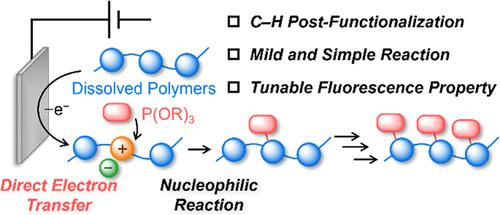在电极上通过直接电子转移溶解共轭聚合物的电化学C-H磷酸化
IF 5.2
1区 化学
Q1 POLYMER SCIENCE
引用次数: 0
摘要
π共轭聚合物(CPs)具有吸引人的光电性能,这是由其主链上扩展的π共轭体系所赋予的。含有极性膦酸基团的CPs因其对金属离子和电极的特殊亲和力而引起了人们的特别兴趣,可以在电化学装置中利用。磷酸基后功能化CPs的一个有利策略是电化学磷酸化,这只需要一个简单的协议,在温和的反应条件下。然而,这种已建立的方法需要CP膜用于电解过程。一种基于传统电解CPs的后功能化方法有望提高电化学磷酸化的通用性和可扩展性。在这里,我们证明了溶解在电解质中的CPs可以通过阳极的直接电子转移进行电化学磷酸化。特别是,我们展示了低电流密度下聚(9,9-二辛基芴)(PFO)的定量磷酸化,尽管PFO的扩散系数很小。搅拌对流促进了聚合物的扩散,从而提高了PFO的电化学磷酸化效率。此外,可以通过调节通过电荷量来精确控制功能化程度。有趣的是,适度的功能化程度将磷酸化的PFO的荧光量子产率提高到0.82,并且可以从各种三烷基亚磷酸盐进行反应。最后,通过密度泛函理论计算确定了阳极磷酸化的反应机理。本文章由计算机程序翻译,如有差异,请以英文原文为准。

Electrochemical C–H Phosphonylation of Dissolved Conjugated Polymers via Direct Electron Transfer at the Electrode
π-Conjugated polymers (CPs) exhibit attractive optoelectronic properties conferred by an extended π-conjugation system along their main chains. CPs containing polar phosphonate groups have attracted special interest because their exceptional affinity to metal ions and electrodes can be exploited in electrochemical devices. A favorable strategy for postfunctionalizing CPs with phosphonate groups is electrochemical phosphonylation, which requires only a simple protocol under mild reaction conditions. However, this established method requires a CP film for the electrolytic process. A postfunctionalization method based on the conventional electrolysis of CPs in solution is expected to improve the versatility and scalability of electrochemical phosphonylation. Herein, we demonstrate that CPs dissolved in an electrolyte can be electrochemically phosphonylated via direct electron transfer at the anode. In particular, we show the quantitative phosphonylation of poly(9,9-dioctylfluorene) (PFO) at low current densities, despite the small diffusion coefficient of PFO. Stirring-induced convection facilitated polymer diffusion, thereby improving the efficiency of electrochemical PFO phosphonylation. Moreover, the degree of functionalization could be precisely controlled by adjusting the amount of passed charge. Interestingly, a moderate functionalization degree improved the fluorescence quantum yield to 0.82 in phosphonylated PFO and the reaction proceeded from various trialkyl phosphites. Finally, the reaction mechanism of anodic phosphonylation was determined through density functional theory calculations.
求助全文
通过发布文献求助,成功后即可免费获取论文全文。
去求助
来源期刊

Macromolecules
工程技术-高分子科学
CiteScore
9.30
自引率
16.40%
发文量
942
审稿时长
2 months
期刊介绍:
Macromolecules publishes original, fundamental, and impactful research on all aspects of polymer science. Topics of interest include synthesis (e.g., controlled polymerizations, polymerization catalysis, post polymerization modification, new monomer structures and polymer architectures, and polymerization mechanisms/kinetics analysis); phase behavior, thermodynamics, dynamic, and ordering/disordering phenomena (e.g., self-assembly, gelation, crystallization, solution/melt/solid-state characteristics); structure and properties (e.g., mechanical and rheological properties, surface/interfacial characteristics, electronic and transport properties); new state of the art characterization (e.g., spectroscopy, scattering, microscopy, rheology), simulation (e.g., Monte Carlo, molecular dynamics, multi-scale/coarse-grained modeling), and theoretical methods. Renewable/sustainable polymers, polymer networks, responsive polymers, electro-, magneto- and opto-active macromolecules, inorganic polymers, charge-transporting polymers (ion-containing, semiconducting, and conducting), nanostructured polymers, and polymer composites are also of interest. Typical papers published in Macromolecules showcase important and innovative concepts, experimental methods/observations, and theoretical/computational approaches that demonstrate a fundamental advance in the understanding of polymers.
 求助内容:
求助内容: 应助结果提醒方式:
应助结果提醒方式:


